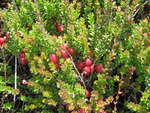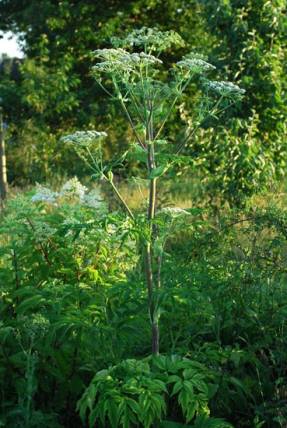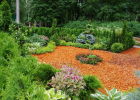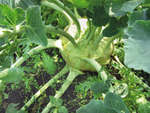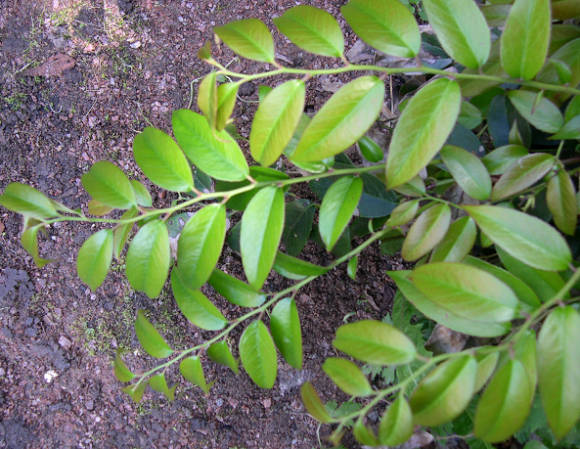
This plant is not intended for decorating areas, although it looks very impressive. But you should still know about it for two reasons: on the one hand, it is poisonous, and on the other, it is an important medicinal culture.
Mad cherry, mad berry, rabies, wolf berries, stupid, sandy berries, sleepy grass, sleeping potion, sleepy stupor, sleepy dope - all popular names with more or less accuracy indicate the symptoms that appear when poisoned with this plant. The generic Latin name "atropa" is given by the name of the goddess Atropa, who, according to ancient Roman myth, could cut the thread of human life at any moment. But the specific name "belladonna" consists of two words bella - "beautiful and donna - "lady, woman", and is associated with its use by medieval beauties to dilate the pupils. At the same time, of course, nothing was visible, but the eyes became shiny and expressive. And beauty, as you know, requires sacrifice. True, the victim was realized only later. In southern Europe, the sun is very bright, and when the pupil remained dilated for a long time, the retina was damaged, as a result of which the beauties were simply blind.
Now this property of the plant is widely used in eye practice. In addition, atropa has many more medicinally valuable properties. But do not forget about the toxicity of belladonna, especially since poisoning with this plant is quite common, especially in the southern regions.
Plant with purple berries
Common belladonna (Atropa beladonna) - perennial herb of the nightshade family (Solanaceae) with a thick, many-headed rhizome. The stem is straight, 60-200 cm high, thick, juicy, forked at the top, glandular - pubescent. Leaves are short-petiolate, ovate or ovate-elliptical, pointed, entire, alternate in the lower part of the stem. The flowers are solitary, large, drooping, brown-violet or red-brown, located in the leaf axils. The fruit is a juicy purple-black, shiny, multi-seeded berry. True, in yellow-flowered forms, it is yellow. Blooms in June-July. The plant propagates in nature only by seeds.
The belladonna plant is highly leafy, but the leaves practically do not shade each other, forming a "leaf mosaic". And this happens due to the fact that they are arranged alternately, but brought together in pairs, and one sheet is always larger than the other.
On the territory of Russia, in the wild, belladonna is found in the Caucasus, the range is represented by several fragments, the largest of which covers the forest belt of the Greater Caucasus Mountains, where it grows at an altitude of 200-1700 m above sea level, on loose humus soils under the canopy of beech forests ... More often only single plants can be found, less often small thickets. Some researchers distinguish it in a separate form - Caucasian belladonna(Atropa caucasica), but most botanists still consider it belladonna belladonna, since it differs only in minor morphological features.
The range of belladonna is very small and this plant was even included in the Red Book of the USSR (1984) and the RSFSR (1988). Now no one is engaged in harvesting wild-growing belladonna, since it has been successfully introduced into culture. Areas with a warm climate, fertile soils and a fairly long growing season are preferred for its cultivation. At present, even a variety of belladonna has been bred - Bagheera, designed specifically for obtaining a leaf for raw materials.
Poison and medicine in one bottle
To begin with, all parts and organs of the plant are more or less toxic, as they contain tropane alkaloids.The amount of alkaloids in belladonna, depending on the growing conditions and the phase of development, fluctuates (in%): in the leaves - from 0.3 to 1.1; in the stems - from 0.11 to 1.15; in flowers - from 0.28 to 0.53; in fruits - from 0.16 to 0.35; in seeds - 0.8 and in roots - from 0.21 to 1.10.
Leaves are used as raw materials in the pharmaceutical industry, less often plant roots. The amount of alkaloids in the leaves should be at least 0.3%, and in the roots - 0.5%.
Let's start with the toxicity of the plant.
Who is in danger

In the past in Europe, poisoning with belladonna berries was a fairly common occurrence, the most famous of which went down in history. In 1813, soldiers of Napoleon's army were poisoned by its fruits while staying near the city of Pirna in Germany, and many of them died. And in Austria, unintentional cases of poisoning with belladonna berries were so numerous that at the end of the 18th century, the government was forced to issue several circulars detailing the plant.
Poisoning more often occurs when eating (especially by children) attractive-looking belladonna berries. By the way, they also taste good. Cases of poisoning have been reported after only 3 berries eaten. Less often, intoxication occurs as a result of an overdose of plant preparations. When working on plantations, toxic effects can be manifested when the hands touch the face and, especially, the eyes.
How does poisoning manifest
It proceeds as an acute psychosis with hallucinations. A detailed description of the symptoms is given in the book by A.P. Efremova "Deadly plants and mushrooms". Poisoning is characterized by motor and speech excitement. There is dryness of the oral mucosa and skin, skin rash, dysphagia, hoarseness, hyperemia of the mucous membranes of the pharynx; thirst, nausea and vomiting, urinary retention, intestinal atony, body temperature may rise. From the side of the eyes - mydriasis and paralysis of accommodation, lack of reaction of the pupils to light. Tachycardia is noted, the pulse is abnormal, rapid (up to 200 beats per minute), possibly an increase in blood pressure. Psychomotor agitation up to a violent state is combined with delirium and convulsions. As the poisoning deepens, Cheyne-Stokes respiration is observed. Symptoms of poisoning develop over a large time range - from 10 minutes to 10-15 hours. In severe cases, death is possible.
The age-old question is what to do?
First of all, quickly deliver the victim to the hospital, and then it is up to the professionals. From first aid - gastric lavage (through a tube, lubricated from the outside with oil) with sodium bicarbonate solution or the introduction of activated carbon in the same way (2 tablespoons per 0.5 l of water), followed by rinsing 15-20 minutes later with a 0.1% solution of potassium permanganate ... For oral administration or through a tube, magnesium sulfate is prescribed (25 g in 2-3 glasses of water).
Belladonna as medicine
Despite all the horrors listed above, belladonna is a valuable medicinal raw material, which the medical industry cannot do without. Of course, it is not intended, like mint or oregano, for home use in teas and infusions.... It is used only as directed by a doctor and in the form of finished dosage forms.
Belladonna preparations are widely used as an antispasmodic and analgesic agent for spasms of smooth muscles of internal organs; in eye practice, they are used to dilate the pupils. Atropine isolated from the plant is used to treat several cardiovascular diseases.
The above drugs include atropine sulfate, dry belladonna extract, thick belladonna extract, belladonna tincture, bacarbon preparations, besalol, corbella. Belladonna is a part of a number of combined preparations: gastric tablets with belladonna extract, belloid, astmatol, suppositories "Anusol", bellataminal, etc.Belladonna preparations are poisonous, have some unpleasant side effects in case of an overdose and are dispensed only on prescription.
pharmachologic effect
Belladonna, as mentioned above, is a highly poisonous plant. But with properly selected doses and in the composition of drugs, the action of its alkaloids can relieve many ailments. Atropine is the main representative of anticholinergic drugs, blocking mainly M-cholinergic receptors. It deprives the receptors of sensitivity to acetylcholine secreted at the ends of the postganglial cholinergic nerves, and thereby disrupts the transmission of nerve impulses from these nerves to the executive organs. This mechanism is associated with its pharmacological effects.
As you already know from the historical background, belladonna juice dilates the pupils. This happens due to atropine blocking the M-cholinergic receptors of the circular muscle of the iris.
In addition, atropine suppresses the secretion of sweat glands, almost all glands of the gastrointestinal tract (salivary, gastrointestinal, pancreas) due to blocking of transmission from cholinergic nerves that innervate these glands (hence one of the characteristic side effects of its drugs - dry mouth ); increases heart rate, relaxes the smooth muscles of the bronchi, stomach and intestines; has a weak effect on the lumen of the bronchi with normal tone, however, during a spasm caused by acetylcholine or other cholinomimetic substances, the drug greatly expands the bronchi. A similar phenomenon is also observed with the action of atropine on the intestines. The drug has a relatively weak effect on normal intestinal motility, at the same time, with spasms, it has a very strong antispasmodic effect.
Application in medicine
Atropine and belladonna preparations are used as a reliable, persistent antispasmodic for diseases associated with spastic conditions, in particular for stomach and duodenal ulcers, pylorospasm, chronic hyperacid gastritis, pancreatitis, for chronic colitis with pain, bronchitis, asthma, concomitant cholecystis stone disease, renal colic. As a bronchodilator, atropine is used in aerosol form.
Atropine is widely used in anesthesiology to prevent side effects from drugs and muscle relaxants. It is recommended to use atropine for pulmonary hemorrhage and hemoptysis, although the mechanism of action of atropine in this case is unclear. Atropine is widely used in ophthalmic practice for therapeutic and diagnostic purposes for iritis, iridocyclitis, keratitis, uveitis. It is also used for poisoning with organophosphorus compounds, cardiac glycosides, morphine, as an antidote for poisoning with certain herbal poisons and drugs: tcarbacholine, muscarin, pilocarpine, for poisoning with proserin, physostigmine and other anticholinesterase substances.
Atropine is contraindicated in glaucoma, it is not prescribed for breastfeeding, as it can worsen lactation. When using atropine, diplopia, photophobia, visual impairment may appear, which is important to consider when prescribing atropine for people whose profession requires high visual acuity, for example, drivers, pilots, etc.

The use of belladonna in homeopathy is very wide. And most importantly, homeopathic concentrations will not cause poisoning. In the classic textbook on homeopathy by G. Köller, belladonna is recommended in the following cases:
- With a sudden rapid onset of an infectious disease with symptoms of heat, redness and a sensation of pulsation, in the initial stage of the formation of a boil, when there is redness, swelling and throbbing pain. Apply C6.
- In the initial stage of furuncle formation, when there is redness, swelling and throbbing pain. Apply C6.
- With bronchial asthma, with a tendency to sudden nocturnal attacks due to fright, anger, cooling, fluctuations in the weather. Apply C30 in solution or beads.
- In acute stroke with the following symptoms: hot red face, wide pupils full of fear, pulsating carotid artery, cold extremities. Apply C6 in solution or C30 in beads.
- With neuralgia with a sudden onset with an acute course at the onset of the disease. Apply C30 in solution.
- With an acute and violent onset of a runny nose and inflammation of the tonsils, as well as at the beginning of stomatitis and gingivitis, accompanied by redness and dryness, belladonna C6 is used.
- For hyperthyroidism, for acute symptoms, C6 is used, and for long-term treatment, C30.
- For hepatic and renal colic, belladonna C6 is used in solution.
- For acute onset of cystitis, a C6-C30 solution is used.
- With acute prostatitis, accompanied by a sensation of swelling of the prostate gland and acute throbbing pain, increased urge to urinate and burning sensation when urinating in the urethra. Apply C6 in solution.

